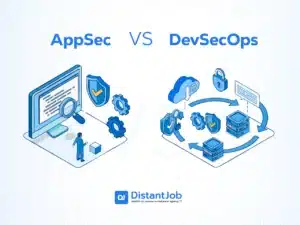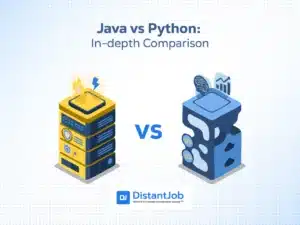One of the biggest dilemmas for a business owner today is ‘given the option of mobile app vs. website, what is the best option to promote my business?’.
According to Statista, people spend around 5 hours daily on their smartphones. So, if you have an online business and want it to succeed, it has to be accessible via mobile phone.
Especially after the global lockdown, 70% of searches on mobile phones lead to online action or purchases. A user can purchase through an app or a mobile website in a matter of seconds.
But the answer of which is the best choice for your business between website vs. app isn’t clear-cut. If you’re wondering, “should I create an app or website?” this article is for you! We’ll present an overview of the pros and cons for both and what you should consider for your company!
App vs. Website: What’s the Difference?
Before diving into the particular details of each one, let’s have a brief overview of each product and its main differences.
Apps are pieces of software that users install on their mobile devices and serve a particular purpose. These are known for being extremely dynamic and allowing user interaction to change the way they work. They don’t present a lot of information at once and rather present it piecemeal as it is relevant.
Websites are a set of web pages with static information (a mix of text and other media such as images, sounds, video, etc.) that users can peruse at their leisure in their web browser of preference. They usually don’t feature a lot of dynamic elements and are more appropriate to present large sets of information at a time.
Web Apps are a mix of the two. The web app is a website that hosts an application that users can interact with. But what exactly is the difference between web apps vs. websites?
Despite being hosted on a website, web apps are made differently from traditional web pages. Web apps, just like pages, are accessible from any device with a browser and internet access but are built to provide a user experience closer to what can be expected of a mobile app. Popular examples of this kind of app are:
- Google Drive
- Dropbox
- Slack
- YouTube
- Spotify
Each of these three options has different purposes and requirements, and as such are better tailored to specific kinds of end goals. Here’s a summary of each type of product:
| App | Web App | Website | |
| Main use | Provide a service and dynamic content to end-users. | Provide a service and dynamic content to end-users. | Provide information and other static content to visitors. |
| Accessible by | A mobile platform. | Web browsers (dependent on features). | Web browsers (dependent on features). |
| User Deployment | User must install it on their mobile platform, and it’s accessible from that point forwards. | No need for installation; immediately accessible from the web browser. | No need for installation; immediately accessible from the web browser. |
| User Updatability | Requires the user to go through an update process (and download) on the app store. | Done on the backend and is immediately available to all users, with no input or installation required. | Done on the backend and is immediately available to all users, with no input or installation required. |
| User Authentication | Depends on the type of app, but it will usually require authentication. | Depends on the type of app, but it will usually require authentication. | Depends on the type of website, but it will usually not require authentication. |
| Discoverability | App store search. | Search engine. | Search engine. |
| Connectivity | It can be used offline or require an internet connection. | Requires internet connection. | Requires internet connection. |
| Development Complexity | The hardest of the three. Besides actual development (which can depend on the target platform and will explode if you consider several platforms at once), there’s also the app store approval process. | The middle ground between the App and Website. It can be complex to develop but can be easily deployed simultaneously to all users without concern for the target platform. | The easiest of the three. Development is far more straightforward since information is mostly static and text-based. |
Apps: Pros and Cons
Today, people do most of their actions online, and mobile app revenues reached $600 billion in 2020. The explosion of smartphones and tablets made application development one of the most popular trends in the world – only in the US, an average app user installs over 100 apps on their devices.
Mobile apps can be:
- Native apps: When a developer writes different code for iOS and Android.
- Hybrid apps: When a developer uses a hybrid platform, such as Xamarin, to create an app that works across any OS with the same code base.
These are the most popular mobile app categories:
- Gaming: Mobile gaming apps are the best alternative to computer video games. Gamers are the most dedicated app consumers. A recent study shows that mobile games account for 33% of app downloads. Candy Crush Saga or Angry Birds are the most downloaded apps ever.
- Productivity: Apps focusing on time tracking, organizing tasks, or improving business efficiency.
- Lifestyle and entertainment: Meditation or fitness apps are increasing their popularity, especially after the global lockdown. Also, socialization apps like Tinder, Bumble, and Instagram, are growing more and more users every day. Another type of entertainment app that has seen a very large growth in the last few years is video streaming apps such as Netflix or Amazon Prime Video.
- M-commerce: Amazon and eBay were among the first businesses to offer the same experience on desktop and mobile versions to their users. These types of apps give users easy payment methods, no matter where they access from, for an optimal shopping experience.
- Travel: From Raynair to Google Maps, Airbnb, or Uber, apps revolutionized the travel industry. These types of apps can function without an Internet connection, so most tourists rely on them both for booking and information at any point in their stay.
Pros
Convenience
Compared to equivalent websites, apps are more convenient. Since apps like Amazon or Zalando have made it easier to browse the company’s products, people do most of their searches online. Measuring how many people use apps vs. websites can be tricky, but recent statistics point out that this year mobile app downloads will reach 258 billion – compared to 168 billion in 2017. In general, people are more likely to use an app tailor-made for a mobile platform than to use the corresponding website in a browser, even if the website is prepared for mobile usage. For example, in the case of Amazon, people will vastly prefer the eCommerce app vs. the website.
Apps offer a better user experience, load content faster, and easily connect to smart devices. In addition, app design suits better than a mobile screen.
Notifications
Unlike mobile websites, apps can send notifications pushing new products and sharing news. For example, if you are running an e-commerce selling food products, you can send notifications when new products or special offers are available. Your customers will see the notification automatically and go into the app to check the details without the need to send emails or other forms of external communication.
Customizable
Mobile apps are a better option for services that you use daily. Users can set preferences and personalize their accounts to keep updated on what they need. A customizable app is a great strategy to target your audience based on their preferences creating specific marketing campaigns for your business.
Offline Access
Unlike mobile applications, apps can work offline, providing access to content and features without an internet connection.
Cons
System Compatibility
As we mentioned initially, mobile apps can be native or hybrid. Sharing the same code through different platforms can be a risk. Hybrid applications might not fully support every feature in each operating system. This limit impacts the user experience and the functionality of the product. On the other hand, building a framework for each operating system is expensive and time-consuming. There’s always a tradeoff.
Accessibility
Unlike mobile websites, apps need to be downloaded and installed. This process can be free of charge for users, but some apps have fees to cover the updating costs and approval system. Depending on the business model you have, your target audience might not be willing to pay extra costs to visit your app or install a new program to use the app.
Support and Maintenance
Developing an app for multiple platforms requires time to maintain and update it to improve compatibility and other such issues. In addition, maintaining an application means constantly running through the approval process in the market where the app is running.

Website: Pros and Cons
Some businesses underestimate the importance of mobile-friendly websites. Just think about how annoyed you get when you open an article from your phone, and you need to resize the page to read it? Would you buy from such a website? Probably not. And the same goes for potential consumers. 61% of users will never return to or purchase from a non-mobile-friendly website. Consequently, 80% of top-ranked websites are mobile-friendly.
There are two main ways to go about implementing a mobile website:
- A user can reach your business on a standard URL website and be redirected to an appropriate version of it based on the platform they are currently using. To do this, a separate site for mobile devices is developed to improve the user experience, and the URL will look like ‘m.company.com’ or ‘company.com/mobile.’
- The website is developed from the get-go with all platforms (including mobile) in mind, and its content adapts based on the real estate that the device’s screen can provide. These are called ‘responsive websites.’
Websites can also take the appearance of apps and are usually called web apps when this is the case. When accessed from mobile phones and tablets, these can also be called mobile web apps. The main content and features of these websites are organized on the mobile screen to facilitate the user’s interactions. Through images, videos, and pop-ups, consumers can easily take information in and purchase products or services.
Pros
Improved User Experience
By creating two separate websites (or creating a responsive website that adapts to your customers’ devices), you can target your audience more efficiently, specifically working on their needs. For example, your web analytics and customer research might indicate that your mobile users prefer a different type of content or features from those browsing from a laptop. By creating a mobile website, you can prioritize actions and features based on your visitors’ preferences.
Compatibility
While an app needs a different version for each operating system, a website is accessible via browser from any type of device. If your target audience uses multiple devices, a mobile website is more accessible and compatible.
Broader Reach
When it comes to reaching potential audiences, mobile websites win the battle. Responsive web design works across various platforms, offering a more comprehensive range of integrated features.
Support and Maintenance
Websites are cheaper to develop and maintain. As we just mentioned, they don’t need a different version for each operating system. In addition, a mobile site doesn’t require downloading updates by users, allowing quicker updating of content and design. Any edit will be immediately visible to users from any device. Finally, as an extension of existing websites, it’s easier to develop features and interactive design.
Better Performance
Mobile websites are designed with smaller screens in mind. Besides providing a better user experience for mobile users, they are made with efficiency in mind so they can be responsive even in the most low-spec devices. They also favor the use of smaller, more mobile-friendly URLs that make them easier to process and navigate.
Cons
Compatibility Content and Features
Tablets and mobile phones are the primary sources to get information. Sometimes, mobile websites can’t provide complete content and features, risking losing users. For example, cameras, GPS, phone dialing, or other integrated features can be limited or don’t have the same efficiency or speed.
In addition, most people interchange a laptop and smartphone in the same interaction. In this case, the screen size can be an issue. A mobile screen will, by its very nature, show less content than a desktop, impacting the user experience.
URL Addresses & Updates
Two URLs are harder to maintain and coordinate. A user should be automatically redirected, but sometimes the process fails. The same type of issue happens when people can like your websites from other pages. Depending on the link, a user can end on a mobile link from a desktop and vice versa. Finally, you must constantly ensure that new products are updated on sites, even when the updating process should happen automatically.
This can be mitigated somewhat with responsive websites, but these can be harder to create than two similar websites with different target platforms.
Offline Access
Besides the challenges related to the user experience, mobile websites don’t work with offline access. Unlike apps, even with a light design, mobile web pages need a strong connection to function fully.
Costs
Besides choosing the most appropriate solution for your needs, budget is by far one of the most important considerations when picking what to pursue will be your available budget.
Indeed, the costs of developing these solutions can be directly correlated with their complexity, so we know that the most expensive will be apps, followed by web apps, followed by websites. But how much does each of these cost exactly?
According to a recent investigation on our part, app development costs will largely depend on the complexity of the app and the people you hire to do it. Prices can go as low as $30,000 and can reach $400,000+. You’ll also need to contend with any support and ongoing costs from operating in the various app stores.
Web app costs can range from $20,000 to $100,000+, depending on complexity and team. Other recurrent annual costs, such as hosting, domain, and SSL certificates, can range from $200 to $2,000 per year.
Finally, websites are the cheapest option of these. Most of the time, you won’t need a web developer and can go by with a web designer since the content isn’t dynamic and won’t need to be programmed. Given that, you can set up a website ranging from $6,500 to $20,000+. Costs with hosting and domain still apply here, so expect extra annual expenses of around $20 to $1,000.
| App | Web App | Website | |
| Average Development Cost | $30,000 – $400,000+ | $20,000 – $100,000+ | $6,500 – $20,000+ |
How to Choose Which Is Right For Your Business?
As with anything, the best choice will depend on your final purpose and your target user base. Here are the considerations you should have when making your choice:
Access
One of the first things you should consider is the way you want people to access your app. If you want your users to access your app from anywhere, then a website or a web app will probably be your best choice. If, however, your user base has a specific type of device you want to target, an app is probably the best choice, as it offers a more comfortable and intuitive experience.
Functionality And Connectivity
Another consideration you should have is the type of functionality you expect from the device you’re targeting. If you’re looking for GPS, SMS, QR code reader capabilities, or motion sensors, for example, then a mobile app will probably be your best bet, as those cannot be found easily on other platforms.
Another big consideration is the use of internet services. If you have a strong need for internet use for your solution to function, then websites and web apps are out of the question.
Upgradability And Lifecycle
Remember that mobile apps, by their nature, have to pass through several steps of control and quality assurance when published to stores. And the same applies to updates. In these platforms, updates take time to be published and can be a detriment if they are frequent.
If you expect your solution to be heavily modified and expanded upon (which is rather frequent at launch), then instead of apps, website apps or even websites are a much better option. If you’re set in an app-like style solution, a web app is a good bet.
Findability And Reach
Is this a solution to increase and grow your online presence? Then it’s time to evaluate your target audience. If you’re unsure, or it’s a wide group of people, you’re better playing it safe and opting for a website or web app, as the devices that can access them are more commonly widespread.
When deciding between a website vs web application in this category, it’s important to evaluate exactly what the purpose of the solution is. If you’re trying to increase the awareness of your brand, a website is the best option. If, however, you’re trying to build a functional product to cater to your customers, a business web app is probably a better solution.
When evaluating the purpose of the solution and considering factors such as findability and reach, it’s crucial to assess whether the focus is on increasing brand awareness or building a functional product to cater to customers’ needs, taking into account the potential benefits of customer relationship automation.
Development Time And Costs
Finally, it’s time to think about your development team as well and what they are comfortable with.
If you have a team with low experience or limited time and budget to implement your solution, a website is your best bet.
Depending on the functionality you expect out of them, apps require a lot more effort, especially if you’re targeting a lot of platforms natively. They are, however, far more engaging to the end user, particularly if your target audience skews toward younger generations.
Web apps sit in the middle of these extremes. They can be built more quickly than an app (and work on any platform by nature), but delivering that app-like feel takes a lot more time than building a simple website and thus cost more.
In Summary
The best advice when it comes to these decisions is to consider the strengths of the platform you’re targeting and see if they match what you’re looking for.
If your end goal is related to marketing or public relations, a responsive mobile website is a better option to grow your online authority. When you are promoting a service that requires regular use, mobile applications win out.
If you’re considering building an app, we’ve put together a guide with valuable resources on how to create a business app plan here.
Ready To Go Forward? Let DistantJob Help You!
Most of our daily actions happen through a phone, and you must decide which is the best investment for your business, between an app or a website. Remember, consider an app if:
- You are selling a service that people use every day or require high security.
- You are selling a service that requires offline actions.
And a website if:
- You are trying to reach marketing-related goals.
- Creating an informative platform like a digital magazine or a landing page.
If a website is still your preferred method of delivering your solution, then consider the pros and cons of a web application vs website.
Ask yourself what you need, and you will know which is the best option. Just remember, both solutions require a great developer to build the most functional and enjoyable product. When you decide what is best for you, make a list of the technical skills you need to build the best app or site. Do you want to push on the user experience with an interactive app? Or give all the possible information to your audience with a smooth mobile website they can access from anywhere?
When you get to this point, DistantJob is here to help you hire qualified developers around the world – literally around the globe! As a remote headhunting agency, we specialize in the tech field with a passion for new technologies and apps. Our IT recruiters can help you figure out the skills you need and the best candidate for your team, either an app developer or a web developer. Just reach out to us online or visit us in our Montreal office!!





